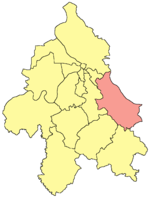Grocka
|
Grocka Гроцка Grocka na Dunavu/Гроцка на Дунаву (trans. Grocka on Danube) |
||
|---|---|---|
| Suburban neighborhood and municipality | ||
|
||
 Location of Grocka within the city of Belgrade |
||
 Location of the city of Belgrade within Serbia |
||
| Country |
|
|
| City | Belgrade | |
| Settlements | 15 | |
| Government | ||
| • Mayor | Dragoljub Simonović (SNS) | |
| Area | ||
| • Municipality | 289 km2 (112 sq mi) | |
| Population (2011 census) | ||
| • Municipality | 83,398 | |
| Time zone | CET (UTC+1) | |
| • Summer (DST) | CEST (UTC+2) | |
| Postal code | 11306 | |
| Area code | +381 011 | |
| Car plates | BG | |
| Website | www |
|
Grocka (Serbian Cyrillic: Гроцка, pronounced [ɡrǒtskaː]) is a suburban neighborhood and one of 17 city municipalities which constitute the city of Belgrade, the capital of Serbia. According to the 2011 census results, the municipality has 83,907 inhabitants.
The municipality is located east of Belgrade, in the northern part of Šumadija region, with the northern section being part of the Podunavlje macro-region in the valley of the Danube, while the southern section is located around the valley of the Ralja river, which is a tributary to the Velika Morava's arm of Jezava. With an altitude of 71 meters above sea level, the town of Grocka is one of the lowest parts of Belgrade. Other rivers in the municipality are Bolečica and Gročica.
The municipality of Grocka covers an area of 289 km² and includes 15 settlements, all of which are statistically classified as rural, except for the municipal seat of Grocka, which is urban. The small town of Grocka is located on the right bank of the Danube, where the small river of the Gročica (Serbian Cyrillic: Грочица) empties into the Danube, 30 km east of Belgrade. Despite being seat of the municipality, in term of population, it is only the fourth largest settlement in the municipality, after Kaluđerica, Vrčin and Leštane.
The municipality has a population of 83,907 inhabitants, according to the 2011 census results. Thanks to the immigration and the natural increase of all of the city's municipalities, Grocka has been for decades one of the fast-growing areas of Belgrade, with an average annual growth of 1.2% in the 2000s. The population boomed in the last 30 years, increasing the number of inhabitants (1971-2011 by 2.38 times; in 1971-81 the population grew by 4.5% annually). As in other similar areas surrounding Belgrade, the rapid population growth has not followed by the equal development of infrastructure (roads, waterworks, sewage system, and waste disposal).
...
Wikipedia

